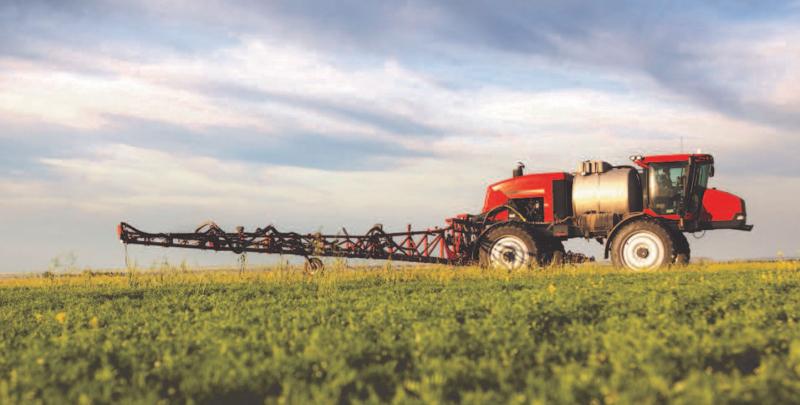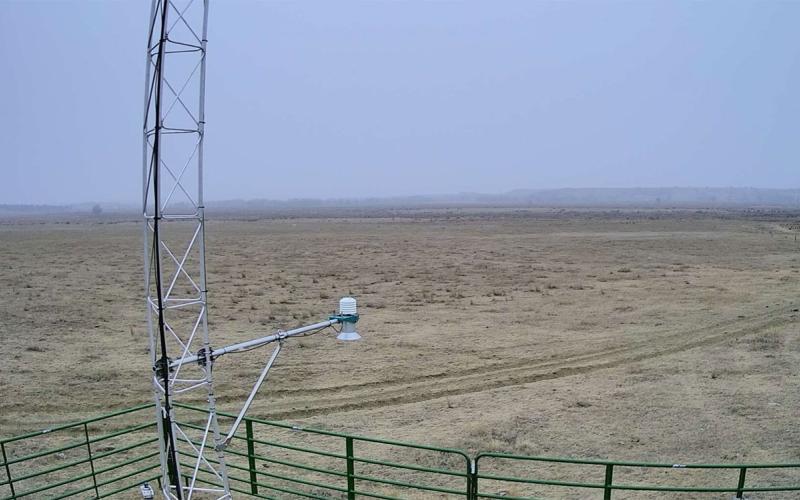Originally written with contributions by Gared Shaffer, former SDSU Extension Weeds Field Specialist.
The goals of applying any crop protection products include: increasing effectiveness, mitigating drift and maximizing profits. We will focus on mitigating drift, even though all three interact with each other. For example, as soon as drift is mitigated (decreased) then that will increase spray effectiveness and in turn maximize profits.
Products used can be harmless to the applied crop, but at the same time could be detrimental to other crops or plant species around. Mitigating applied product drift should be a top priority for all applicators. Weather is the primary factor influencing drift, including wind (direction and speed), temperature, humidity and air stability/inversions.
Common Questions
What is drift?
Drift is movement of spray particles and vapors off-target causing less effective control and possible injury to susceptible vegetation, wildlife and people. Vapor drift is associated with volatilization (gas, fumes). Particle drift is movement of spray particles during or after the spray application.
Why should we be interested in drift?
Drift may cause spotty pest control, wasted chemicals, off-target damage to high value specialty crops, higher production costs, and negatively affect the environment (water and air quality). Drift also increases the occurrences of problems arising with neighbors and the public’s negative perceptions of pesticides.
Factors Affecting Drift

Factors affecting drift are spray characteristics of the actual chemical, chemical formulation, droplet size and evaporation. The equipment used with application can effect drift by the nozzle type, nozzle size, nozzle pressure, height of release chosen by the applicator and sprayer calibration. Weather factors affecting drift include air movement (wind direction and speed), temperature and humidity, air stability/inversions and topography.
Wind direction is very important. Applicators should know the location of sensitive crop areas and consider safe buffer zones. SDSU Extension does not recommend spraying at any wind speed if it is blowing towards sensitive areas. We do recommend spraying when the breeze is gentle, steady, and blowing away from sensitive areas. Drift potential is lowest at wind speeds between 3 and 10 mph (gentle but steady breeze) blowing in a safe direction.
“Dead calm” conditions are not recommended, because drift potential may be high. This is because light winds (0-2 mph) tend to be unpredictable and variable in direction. Calm and low wind conditions may indicate presence of a temperature inversion.
Wind speeds may be different when moving from within the crop canopy to above the crop canopy. Wind speed and direction can drastically affect spray droplet displacement, as structures can affect the wind currents around windbreaks, tree lines, houses, barns, hills and valleys.
Under normal weather, air tends to rise and mix with air above. Droplets will disperse and will usually not cause problems. Temperature inversions are caused when the temperature increases as you move upward in the atmosphere. This prevents air near the surface from mixing with the air above it. Therefore, inversions cause small-suspended droplets to form a concentrated cloud, which can move in unpredictable directions.
Temperature inversions often occur under clear to partly cloudy skies and light winds during the overnight hours; a surface inversion can form as the sun sets. Under these conditions, a surface inversion will continue into the morning until the sun begins to heat the ground. Be careful near sunset and an hour or so after sunrise, unless there is low heavy cloud cover, if the wind speed is greater the 5-6 mph at ground level or there is a 5-degree temperature rise after sun-up.
Mitigating Drift Through Nozzle Selection
Industry today has numerous options for nozzles designed to reduce drift, improve droplet size and enhance overall spray quality than ever before. Nozzle tips are important to control the rate of product delivered, uniformity of application, and coverage which can still influence the drift potential of a product. Appropriate nozzle tips are always stated/recommended on the product label.
Spray Droplet Size
The effectiveness of the product and drift potential is influenced by the size of the spray droplets (volume median diameter-VMD) and droplet spectrum (range big to small). Spray droplets are measured in microns (1 micron = 1/25,000 inch). A comparative everyday example is a pencil lead which is 2000 microns, paper clip 850 microns, staple 420 microns, toothbrush bristle 300 microns, sewing thread 150 microns and a human hair around 100 microns. When selecting nozzle tips, there are options ranging from extremely fine to ultra-course, refer to Table 1.
Spray droplet size also influences spray coverage. As spray droplet size increases, spray coverage decreases. As a rule of thumb select nozzles, tip sizes and operating pressures that produce large enough spray droplets to reduce the risk of drift, while giving adequate coverage for the pesticide type used (Medium to Course). Spray droplets < 200 microns in diameter are light and remain airborne for a longer time and are most prone to drift.
| Category | VMD (Microns) | Color Code |
|---|---|---|
| Extremely Fine | ≈50 | Purple |
| Very Fine | <136 | Red |
| Fine | 136-177 | Orange |
| Medium | 177-218 | Yellow |
| Coarse | 218-349 | Blue |
| Very Coarse | 349-428 | Green |
| Extremely Coarse | 428-622 | White |
| Ultra Coarse | >622 | Black |
Data extracted from America Society of Agricultural & Biological Engineers (ASABE) S-572, March 2013.
Keep these strategies in mind when planning to spray herbicides:
- Select correct nozzle for product to increase droplet size and decrease spray fines.
- Increase flow rates-higher application volumes.
- Use lower pressures.
- Use lower spray boom heights.
- Avoid adverse weather conditions.
- Consider using buffer zones.
- Consider using new technologies:
- Drift reduction nozzles
- Drift reduction additives
- Shields
If label recommendations for tip usage are not followed, drift and misapplication will surely follow.
Non-Chemical Weed Control
Non-Chemical ways to suppress weed pressure in the field can be cost-effective and highly sustainable in a long run. Herbicides are only one of the tools that are available to us. Below is the example specific to weed pressure. Keep in mind three ways to slow weed pressure:
- Competition: Narrow cash crop rows planted in optimal conditions can speed up canopy cover, giving competition for sun light. Wider rows with inter-seeded cover crops can also provide competition to annual weeds. Practicing no-till to keep the soil covered will also aid in weed competition.
- Sanitation: Buy weed free seed. Keeping combines and other implements weed free will decrease weed seed spread to other fields.
- Rotation: Growing crops with various growth habits will not only widens the production selection, allowing better weed control but also enhances soil health.


